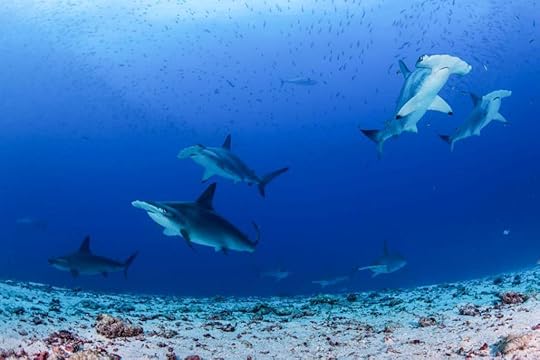At Swim With Five Tons of Shark Per Acre in the Galapagos

(Photo: Enric Sala/National Geographic)
Yep, that’s how many sharks researchers found living in the northern Galapagos Islands, according to a new study in PeerJ. And of course the researchers found out by diving and swimming transects to count the fish they saw en route. Not sure this would qualify as “nice work if you can get it.”
They did the research around Darwin and Wolf Islands, in part of Ecuador’s .
The results:
Nearly 73% of the total biomass (12.4 ± 4.01 t ha−1) was accounted for by
sharks, primarily hammerheads
(Sphryna lewini—48.0%), Galapagos (Carcharhinus galapagensis— 19.4%), and blacktips (Carcharhinus limbatus—5.1%). Hammerheads occurred on 92% of transects at SE Darwin, 59% at SE Wolf, and 9% at both NW Darwin and Wolf. Gringos (Paranthias colonus) were the third most abundant species by weight, accounting for an additional 18.3% of the total biomass. They were 2.2 times more abundant by weight in 2013 (3.8 ± 4.1) compared with 2014 (1.7 ± 2.4). Gringos were 48% more abundant in the SE (3.5 ± 3.5) compared with the NW (2.4 ± 3.7) exposures.
That figure, 12.4 ± 4.01 t ha−1, works out to a little more than five tons of shark per acre. The abundance is partly a result of a unique confluence of ocean currents:
Galapagos is the only tropical archipelago in the world at the cross-roads of major current systems that bring both warm and cold waters. From the northeast, the Panama Current brings warm water; from the southeast the Peru current bring cold water; and from the west, the subsurface equatorial undercurrent (SEC) also bring cold water from the deep (Banks, 2002). The SEC collides with the Galapagos platform to the west of the Islands of Fernandina and Isabela, producing very productive upwelling systems that are the basis of a rich food web that supports cold water species in a tropical setting like the endemic Galapagos penguin (Spheniscus mendiculus) (Edgar et al., 2004). The oceanographic setting surrounding Galapagos results in a wide range of marine ecosystems and populations, that includes from tropical species like corals or reef sharks to temperate and sub-Antarctic species like the Galapagos fur seal (Arctocephalus galapagoensis) or the waived albatross (Phoebastria irrorata).
The far northern islands of Darwin and Wolf in the 138,000 km2 Galapagos Marine Reserve (GMR) represent a unique ‘hotspot’ for sharks and other pelagic species (Hearn et al., 2010; Hearn et al., 2014; Acuña-Marrero et al., 2014; Ketchum et al., 2014a). Most of the studies around this area have focused on the migration of scalloped hammerhead sharks (Sphyrna lewini) and other sharks species between Darwin and Wolf and other localities in the Eastern Tropical Pacific (Hearn et al., 2010; Bessudo et al., 2011; Ketchum et al., 2014a). An ecological monitoring program has visited the islands over the past 15 years with a strong sampling focus to survey reef fishes and invertebrate communities (Edgar et al., 2011). However, no study to date has examined extensively the abundance, size, and biomass of sharks and other large predatory fishes around Darwin and Wolf. We conducted two expeditions to Darwin and Wolf in November 2013 and August 2014 to establish comprehensive abundance estimates for shark and predatory fish assemblages at Darwin and Wolf.
The researchers urged Ecuadorian officials to provide strict enforcement of their new marine reserve, at a time when overfishing has decimated stocks of sharks and other large predatory fish, now down by an estimated 90 percent worldwide.





